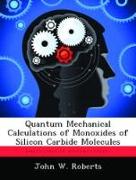Quantum Mechanical Calculations of Monoxides of Silicon Carbide Molecules
BücherAngebote / Angebote:
Modern semiconductor devices are principally made using the element silicon. In recent years, silicon carbide (SiC), with its wide band-gap, high thermal conductivity, and radiation resistance, has shown prospects as a semiconductor material for use in high temperature and radiation environments such as jet engines and satellites. A limiting factor in the performance of many SiC semiconductor components is the presence of lattice defects formed at oxide dielectric junctions during processing. Recent theoretical work has used small quantum mechanical systems embedded in larger molecular mechanics structures to attempt to better understand SiC surfaces and bulk materials and their oxidation. This research uses quantum mechanical models to calculate geometries and electronic properties of small SimCnO molecular clusters of silicon carbide oxides with 0 [less than or equal to] m, n [less than or equal to] 4. Calculations are primarily done using Hartree-Fock and Density Functional Theory (DFT) with the B3LYP exchange and correlation functionals. Meuller-Plesset Second Order Perturbation (MP2), Configuration Interaction (CI), Multi-Configurational Self-Consistent Field (MCSCF), and Coupled Cluster (CC) are used on the CSi2O molecule to confirm the accuracy of selected levels of DFT. Molecular properties examined include ground state multiplicity, vibrational modes and frequencies, and geometry for both the neutral and anion, adiabatic and vertical electron affinities, and thermodynamic heats of formation. Qualitative predictions are made regarding the photoelectron spectrum experimentalists may see. Finally, preferred geometries, functional groups, and bonding locations are qualitatively determined. Later research will be able to use these results to study the oxidation of larger SiC structures and surfaces and their defects.
Folgt in ca. 15 Arbeitstagen





